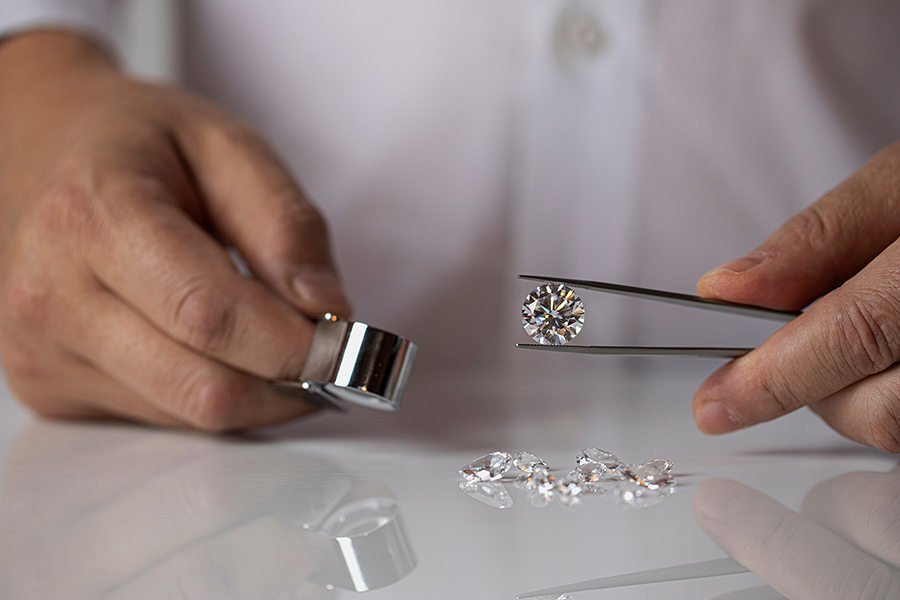31 January 2024
Spotlight
Growing Purchasing Power and Young Women's Aspirations Drive Diamond Jewellery Sales
Ghanshyam Dholakia, Founder and Managing Director of diamond behemoth Hari Krishna Exports Private
Ltd, is a well-known industry face. We caught up with him to discuss the diamond jewellery business scenario in
India. Gung-ho about the growth of the diamond sector, particularly the jewellery segment, Dholakia strongly pitches
for ‘Design in India’ to make India’s presence felt across the globe. Also, he has a piece of
advice for diamond jewellery lovers: ‘Go for the trusted brand’.
Here are the excerpts:

Where does the global diamond trade stand today as far as India is concerned? What factors are driving
trade?
The diamond business is doing well in India. The financial year 2023 was better than the previous year (2022),
and the situation is further improving. Two factors are driving the growth in the Indian diamond industry: the
shift from gold to diamonds and the young population’s growing aspirations and buying power. Compared to a
few years ago, diamonds are increasingly becoming Indian families’ choice vis-à-vis gold when it
comes to buying jewellery. This shift coupled with young women’s fascination for diamond jewellery has
created a win-win situation for the industry. More and more women are joining the workforce and spending on
themselves. Today’s customers are looking for quality products at competitive prices and whichever company
can fulfil these criteria, stands to gain.
Transparency, perhaps, is another reason for the diamond trade to flourish in India.
David Kellie, CEO of Natural Diamond Council, recently asserted that India is poised to lead the global
natural diamond demand in 2024. What do you make of it? Which other markets are raring to go?
I fully agree with him. It’s all about spending power. As jobs are being created and people’s
earnings are on the rise, families are loosening their purse strings and where better to spend than jewellery!
People are buying more and buying better. Indian parents want to gift the best jewellery to their daughters, and
they start saving for it early in their working lives.
Besides India, Indonesia, Brazil and South America are witnessing steady growth in demand.

How good
is the export situation?
It’s a
mixed bag for the mined diamonds. Demand in Europe is steady as lab-grown diamonds have not been able to
make a dent there. The growth in the US, China and Hong Kong is a bit slow although the American market has
been growing of late. The people in the US use lab-grown diamonds as fashion accessories but for formal
occasions and ceremonies, mined diamonds are their first choice.
We will get
better clarity about the situation of the markets in mainland China, Hong Kong, Japan, Singapore, Japan,
Vietnam, and Malaysia after the HKTDC
Hong Kong International Jewellery Show, which will be held from Feb 29 to March 4.
As the cost of lab-grown diamonds keeps reducing, how do you see its impact on the industry? Are Indian
diamond dealers ready to make the best of this situation?
The impact has yet to show. Owing to traditional consumer behaviour, Indians do not readily accept lab-grown
diamonds. For us Indians, resale value is one of the determining factors when we invest in an expensive product.
Unlike natural diamonds, lab-made gems do not offer a guaranteed resale value. Moreover, consumers still
consider only mined diamonds as family heirlooms. In certain countries, such as the US, a distinct consumer
approach has led to a preference for purchasing lab-grown diamonds. Regarding the production of these diamonds,
Indian manufacturers are actively involved and demonstrating commendable performance in this field.
India has the traditional advantage of easy availability of skilled workers, state-of-the-art technology,
and lower costs, what extra do we need to do to maintain our edge over our competitors?
India should work on the design aspect in a big way, and the sooner we do it the better. ‘Design in
India’ should be our focus. There is a huge international market to conquer. Indians everywhere in the
world will love to wear the jewellery designed in India. Why shouldn’t Indian designs be making a splash
globally when we see foreign jewellery brands coming to India? It’s time for Indian jewellery designs to
conquer the world market.

The newly-opened state-of-the-art Surat Diamond Bourse is a new feather in India’s cap. Do you think
it will be a game-changer for the global diamond trade? How will it particularly help the Indian
industry?
It adds to India’s profile as a leader in diamond manufacturing and trade. The Surat Diamond Bourse will
attract diamantaires visiting Mumbai from other countries, thus benefiting small manufacturers.
What are the diamond industry’s expectations from the government which is keen on promoting the Make
in India programme?
The government has been supportive of the entire industry, not diamond manufacturers and traders alone. It
focuses on the ease of doing business in every sector and is making the right moves to promote manufacturing and
exports.
After a dynamic three-decade journey, where do you think Hari Krishna Exports stands today?
Thanks to our goodwill and trust, Hari Krishna Exports, like the rest of the Indian diamond industry, is on a
steady growth path.
How do you ensure the professional development of such a large and varied workforce?
We have put a system in place to train our people throughout the year. An in-house training centre takes care of
skill development at all levels.
How is Kisna, the jewellery arm of Hari Krishna Exports, doing?
Pretty well. Kisna has a presence in 86 countries. Its products are displayed at 1,700 showrooms across India and
the company has 17 franchisee showrooms. By March-end, we will have 25 franchise shops. We recently launched a
solitaire ring priced at Rs 29,000.
What would be your advice to diamond jewellery lovers?
Go for the trusted brand or jeweller so that the sparkle lasts forever.